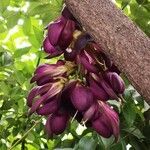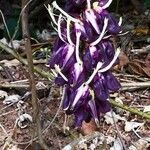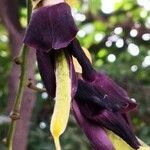Woody vines, up to 25 m. Old stems over 30 cm in diam., young stems glabrous or rarely with sparse stiff pale hairs. Leaves 20-40 cm; petiole 7-16.5 cm, glabrous or with sparse hairs like stem; stipels not persistent; leaflets papery or thicker textured, glabrous or with fine pale stiff hairs, lateral veins 4 or 5 pairs, gently curved; terminal leaflet elliptic or elliptic-ovate, 8-15(-19) × 3.5-9 cm, base slightly cuneate, apex acuminate to 15 cm; lateral leaflets 7-14 cm, width ratio of abaxial to adaxial halves 1.25-1.5:1, abaxial half with base often truncate or slightly cordate. Inflorescences usually on old stems, 10-36 cm, with 5-10 nodes throughout length; bracts caducous, narrowly obovate, ca. 1.5 mm long and wide; bracteoles ovate or obovate, caducous; pedicels 1-2.5 cm, with stiff dark short adpressed hairs. Calyx with dense adpressed hairs on both sides and sparse caducous bristles outside; tube 8-12 × 18-25 mm; lateral lobes 5-8 mm, equaling lowest lobe or almost so, broadly triangular, upper lip often equaling lateral lobes. Corolla deep purple, black after drying; standard 3.2-4 cm; wings rather wide, 4.8-6 × 1.8-2 cm; keel 6-7 cm. Legume linear, straight or slightly curved, 30-60 × 3-3.5 cm, 1-1.3 cm thick, woody, with dense short fine red-brown hairs and sparse caducous reddish brown bristles, surface with conspicuous irregularly reticulate patterning, margins and surface constricted between seeds, base often with abrupt narrow neck, margin thickened into a well-defined smooth rounded ridge running along suture without a wing or median groove, apex acute. Seeds 4-12, shiny red, brown, or black, oblong or discoid, 2.2-3.2 × 2-2.8 cm, ca. 1 cm thick; septum woody; hilum black, length ca. 3/4 of seed circumference. Fl. Apr-May, fr. Aug-Oct. 2n = 22, 44.
More
A creeper. The fruit are on the main vine. The small branches are hairy. The leaves have 3 leaflets. The end leaflets is oval and the side ones are oblique. The flowers are rose-purple. They are 6.4 cm long. They are in long hanging groups. The pods are oblong and 7-12 cm long by 1 cm wide. There are 8-12 seeds. They are 10-12 mm long by 8-10 mm wide.




